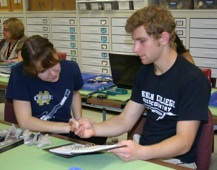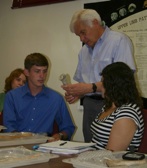A National Science Foundation Research Experiences for Undergraduates Site
Department of Anthropology, University of Notre Dame, Notre Dame, IN 46556


Guest Scientist(s)
Prof. Christopher Schmidt has written widely on the morphological changes associated with burned bone. He provided a hands-on module about the taphonomic changes associated with burning.

Jessica Mayercin [Ohio State University] & Adeline Lustig [University of Idaho]
This paper utilizes a biocultural approach in the examination of burned ilia from charnel house A22, located at Bab edh-Dhra’, Jordan. Subadult and adult ilia were examined in order to determine any differences in regards to degree of burning (i.e., did one group burn more or less) and placement within the charnel house. Degree of burning was determined by comparing two anatomical landmarks on the ilia using a Munsell color chart, followed by assigning each Munsell notation to one of eight general color categories. Bone follows a predictable pattern of color change when burned, thus we defined color categories in order of least- to most-burned as: Pale Brown/Yellow (1), Light Brown (2), Dark Brown (3), Black (4), Dark Gray (5), Light Gray (6), Blue Gray (7) and White (8). Plotting the provenience of adult and subadult remains within A22 allowed us to determine if subadults were buried separately from adults, a trend that is seen throughout the Early Bronze Age. No statistically significant differences were found with regard to burning color or placement within A22. Therefore, Bab edh-Dhra’ is a fairly unique site within the Levant region and the Early Bronze Age. One potential explanation for the intermixed nature of adult and subadult remains is a continuation from the Early Bronze IA/IB period in which individuals were buried according to kinship and descent groups. Further research is needed in order to further confirm the genetic relatedness of individuals from charnel house A22.

Aaron Wolf [Oberlin College] & Theresa Gildner [University of Notre Dame]
In this study a Munsell Color Chart was used to assess bone color on two areas on the distal ends of humeri excavated from charnel house A22, located at the Early Bronze Age site of Bab edh-Dhra. This analysis was performed to determine if the bones were intentionally cremated, or if the burn patterns were due to the charnel house fire that destroyed A22. The degree of burning on the humeri in five different regions of the charnel house was also examined for any discernable burn patterns present in A22. The findings indicate that there is no significant difference in burn color between the articular and non-articular surfaces, suggesting that primary articulated cremation was likely not performed at Bab edh-Dhra. Additional results imply burning was concentrated along the periphery of the house, particularly along the east wall.

L*a*b* Color Analysis of the Proximal Femora: Burning at Bab edh-Dhra’ Charnel House A22
Martin Fernandez [Syracuse University] & Noah Dunham [Illinois Wesleyan University]
In order to weigh the possibilities for the medium of their burning, the proximal femora of Bab edh-Dhra’ charnel house A22 were subjected to a burn color analysis. The analysis employed the three-dimensional CIELAB model through use of an X-Rite SP-60 spectrophotometer. Color measurements were taken on two distinct spots: near the fovea capitis and the lesser trochanter. Specimens were also grouped into eleven general color categories, of which the three pre-carbonization colors were excluded for statistical tests. Three hypotheses were then tested. The first tested for tissue shielding-consistent with articulated cremations-and involved only specimens with both spots present. All specimens were then tested through two provenience models for differential burning, based on archaeological observations and a comparative study respectively. The findings of this study’s color analysis were not consistent with articulated cremation patterns. They were also not consistent with the archaeological spatial observations of concentrated burning. Though the results were inconclusive for the provenience models, the CIELAB mode of color analysis proved itself to be objective and reliable.

Katie Whitmore [Arizona State University] & Elena Rodriguez [University of Notre Dame]
Heat related deformations such as warping, delamination, and deformative fractures can be used to determine whether bones were burned in a wet or fleshed state (Baby, 1954; Binford, 1963; Pope and Smith, 2004; Thompson, 2005; Symes et al., 2008). This study investigated skeletal remains from charnel house A22 from the site Bab edh-Dhra’, Jordan. The study specifically looked at whether the remains were burned in a wet or dry state and whether there was any pattern of burning within the charnel house. Four hundred and thirty-nine regions on 122 frontal bones were individually scored for the presence or absence of warping, delamination, and deformative fracturing. There was no difference in the presence of deformations between specimens from the left or right side. Specimens from the right side were further analyzed and showed no difference in warping (p=0.41715), delamination (p=1), and deformative fracturing (p=0.16764) by region. The lack of directional burning in addition to a comparison of other known sites indicated that the bones were burnt in a dry state. Provenience was analyzed using all specimens. There was no evidence of a pattern of burning for warping (p=0.008964), delamination (p=0.439315), or deformative fracturing (p=0.091374) in the charnel house.

You Give Me Femur:” Burned Distal Femora in Charnel House A22 at Bab edh-Dhra’, Jordan
Samantha Wade [SUNY-Oneonta] & Seth Vissette [University of North Carolina-Chapel Hill]
The main goal of this study was to analyze the presence of heat-related postmortem fracture patterns in 128 burned distal femora from charnel house A22 at Bab edh-Dhra’, Jordan. Longitudinal fractures, deformative warping, and checking, cracking, and patina were examined to determine whether the bones were burned in a more relatively fresh or dry state. Analysis of freshness was inconclusive, suggesting a possible comingling of dry and fresh remains within the charnel house. Encompassing the bioarchaeological model, the provenience of the bones was inspected to connect daily lives and mortuary practices of the population as a whole to the biological remains. The provenience data may suggest that a transverse wall within charnel house A22 was built at a later date, as well as indicating the presence of looters. Comparison with other sites of similar situations was used in attempt to further determine freshness of the Bab edh-Dhra’ sample, but the degree of fragmentation in most of the comparative material was too great to be conclusive. In the future, color analysis and more consensuses on fracture patterning are necessary to provide a better understanding of thermal fracturing and the remains at Bab edh-Dhra’, Jordan.
\


Previous NSF-REU Summers
A summary of previous research projects can be found:





Through the generous support of the Institute for Scholarship in the Liberal Arts at the University of Notre Dame, we were able to invite a second guest scientist in 2010. Prof. Donald Ortner returned to provide a two-day paleopathology module
-
✦Natural History Museum at the Smithsonian









